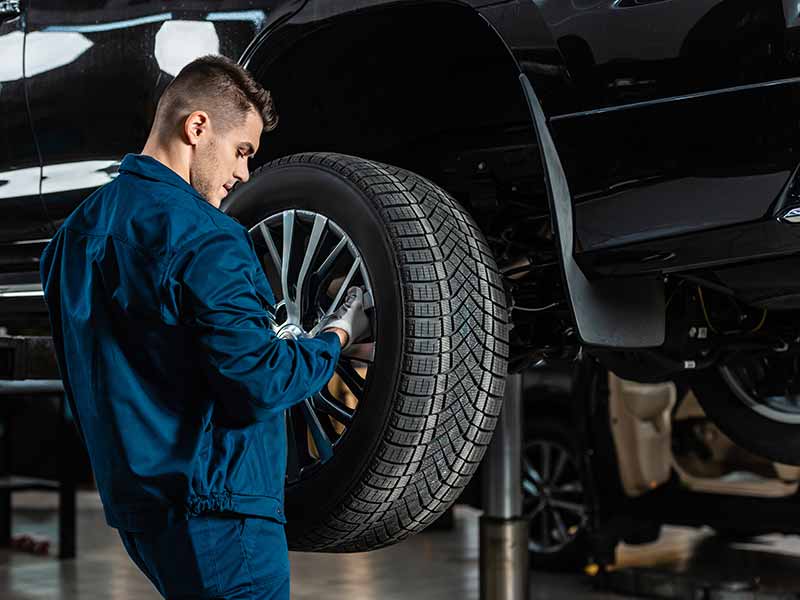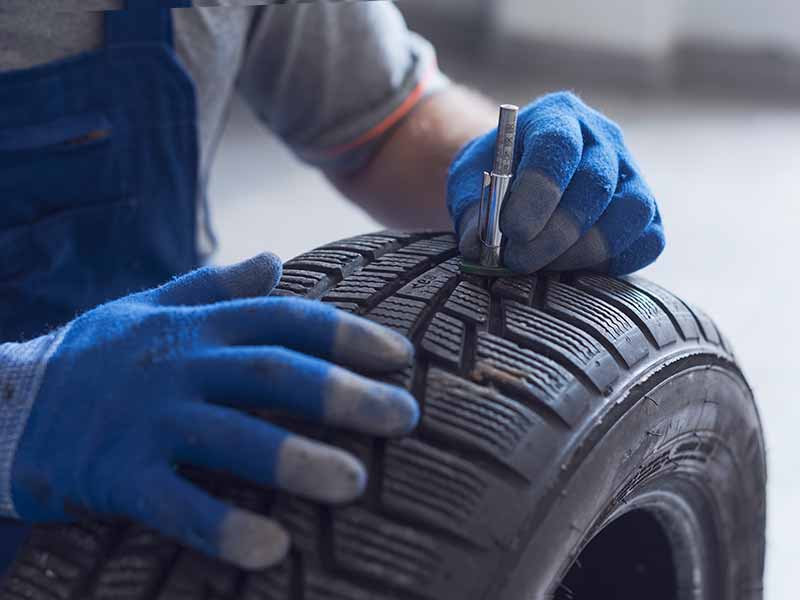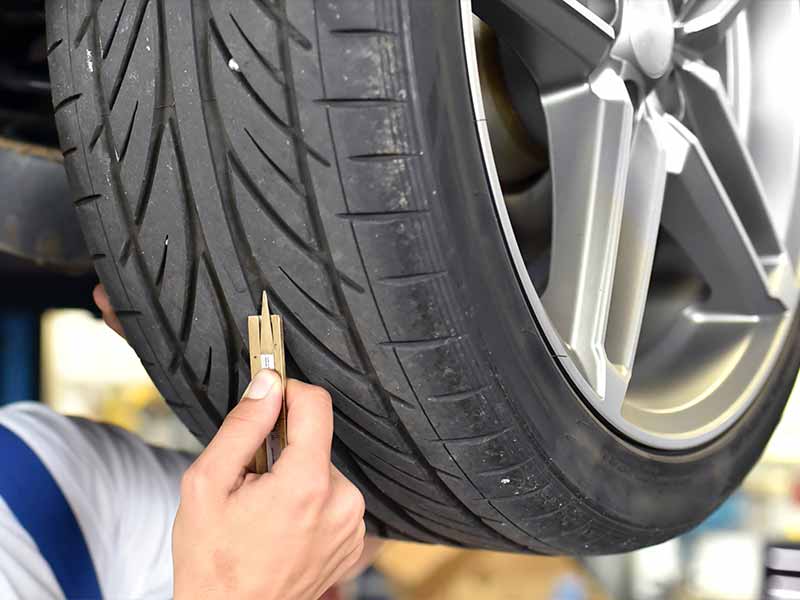A 5,000 mile tire rotation schedule is often recommended. There are some very good reasons for this but it doesn’t mean that it is necessary.
How often should you rotate your tires? The best option is to make sure you follow the guidance provided by the tire manufacturer for your specific tires.
Do You Need To Rotate Your Tires Every 5,000 Miles?
You do not need to rotate your tires every 5,000 miles, but it is highly recommended. You should check your tires warranty requirements to make sure that you have your tires rotated at least as often as is required to maintain the warranty.
Let’s cover the benefits of 5,000 mile tire rotations and why you may want to consider this rotation schedule for your car or truck.

How Long Can You Go Without Rotating Your Tires?
You should only go the amount of miles required to maintain your tire warranty or less without rotating your tires. Most tire manufacturers will require tire rotation to be performed every 5,000 to 8,000 miles or they will not honor your tire warranty.
Aside from the requirement to maintain your tire warranty, you can never rotate your tires and possibly not notice any problems.
How Often Do You Really Need To Rotate Tires?
Having your tires rotated every 5,000 miles is a very good interval to have your tires rotated but it isn’t required. To maintain your tire warranty you should refer to the paperwork that came with your tires and follow the requirements for maintaining your tire warranty.
Most tire manufacturers will require tire rotation be performed between 5,000 and 8,000 miles. I recommend trying to your tires every 5,000 miles to give yourself a little buffer between the warranty requirement and the 5,000 target.
It’s best to have your tires rotated during another maintenance service appointment. Tire rotation is often free when having another service performed. You will also save time waiting and driving to and from your mechanic for simple tire rotations.
Why Rotate Tires Every 5000 Miles
5,000 mile tire rotation is a good schedule to follow for several reasons:
- This schedule usually provides a buffer to allow you to try to schedule tire rotation with other service appointments to save you time.
- More frequent tire rotation will improve traction and tire wear as well as reduce noise and vibrations better than longer schedules. Even tire wear can improve safety.
- Tire inspections occur during rotation and this will help you stay ahead of alignment and tire balance problems before they can cause significant tire wear.
- Rotating your tires every 5,000 miles will save you money. Regular tire rotations will add life to your tires and help you keep them gripping their best for longer.
Should I Rotate My Tires Every 5000 Miles
I recommend tire rotation every 5,000 miles mainly for the buffer it will allow you before the tire warranty required mileage. Most tire warranties will have slightly more mileage allowance before requiring a tire rotation.
The extra mileage helps give you a little wiggle room to try to have your tires rotated at the same time as another vehicle maintenance service. Whether you have other regular services that occur, a non-urgent service, or an unexpected repair, combining appointments will save time and help you to better follow through on regular tire rotations.
It’s easy to procrastinate on a task that doesn’t provide an instant noticeable difference. These small and consistent efforts add up over time and make a significant difference in the end.

Is Tire Rotation Necessary
Tire rotation is usually necessary to maintain your tire warranty. Most tire manufacturers will require that you rotate your tires between 5,000 and 8,000 miles.
If regular tire rotations aren’t performed according to the tire manufacturer requirements they will not honor the mileage warranty.
Tires will wear more evenly, last longer, ride smoother, and create less road noise when properly rotated. These benefits don’t make regular rotation necessary, but they will usually pay for themselves, especially if you have rotations performed at service appointments for other vehicle maintenance requirements.
How Often Should You Rotate Your Tires
The longest you should wait between tire rotations is the maximum allowable for your tire warranty. The biggest benefit of having your tires rotated is the maintenance of your mileage warranty.
There are many factors that affect tire wear. Some cars and trucks will wear tires more quickly than others and normal conservative driving may not be enough to achieve the guaranteed mileage.
If you happen to have a vehicle with more aggressive suspension settings it makes good financial sense to have your tires rotated according the requirements to ensure your warranty doesn’t get voided.
Is It OK To Rotate Tires Every 10,000 Miles
10,000 miles is typically more mileage than most tire warranties will require. If you exceed the miles required to have your tires rotated by in your warranty you will not be able to claim a refund on the difference if you end up with excessive tire wear.
Also, not rotating your tires according to the manufacturer’s schedule will cause the tires to wear out more quickly and allow problems that cause uneven tire wear to go undiagnosed for longer periods of time.
When Not To Rotate Tires
There are very few situations when you shouldn’t rotate your tires but there are two situations where this is true:
Tire Tread Depth Less Than 4/32″
If your tires have less tread depth than 4/32″ they should be replaced and not rotated. Tires lose their ability to shed water as they wear down and once there is only 4/32″ of tread depth left they are at the point where they can no longer shed water very well at all and you risk hydroplaning.
4/32″ of tread is 2/32″ above the tread wear bars. Once the tread wear bar has been reached you should stop driving on the tires and have them replaced immediately.
Directional Tires With Staggered Wheels
Directional tires can only be rotated front to back. Staggered wheels can only be rotated side to side. When a vehicle has both directional tires and staggered wheels tires can not be rotated.

Directional Tires
Directional tires have tread patterns that are designed to function only when spinning in one direction only. Once mounted onto a wheel they can only be used on one side of the vehicle.
You can tell if you have directional tires by checking your sidewalls for an arrow that indicates which direction the tire should spin. Do not confuse this with asymmetrical tires which will have a sidewall indicator that explains which sidewall should be facing outward. Asymmetrical tires can spin in either direction.

Staggered Wheels
Staggered Wheels are when the wheels mounted to the front and rear axles are different sizes. This is common on rear wheel drive sports cars which benefit from wider rear tires. The wider contact patch helps improve traction when accelerating and helps to prevent oversteer when cornering.
It should be obvious that if wider rear wheels and tires are used to improve handling, the wider wheels and tires need to remain on the rear and can’t be rotated to the front. Often this isn’t even possible since the rear tires and wheels will be too wide to properly fit on the front.
Tire Rotation Patterns
There isn’t just one pattern to rotate your tires. There are several different patterns with each optimized for different benefits.
For the best pattern for rotating your tires you should refer to the owner’s manual of your car or truck. While most rotation patterns are designed around the axle driving the wheels, your vehicle manufacturer may have different suggestions.
We won’t cover them all here but we will cover the most common ones:
Forward Cross
The forward cross tire rotation pattern is optimized for front wheel drive vehicles and involves rotating the rear tires forward and across to the opposite sides of the car or truck.
Rearward Cross
The rearward cross pattern is ideal for rear wheel drive vehicles and involves rotating the front tires rearward and across to the opposite sides of the car or truck.
X-Pattern
The X-pattern is ideal for all wheel drive vehicles and involves rotating the front tires rearward and across and the rear tires forward and across to the opposite sides of the car or truck.
Final Thoughts
Tire rotation is necessary to maintain the mileage warranty provided by your tire manufacturer. 5,000 miles between rotations will usually meet or exceed that requirement but you should check the paperwork provided with your tires to make sure that this is the case.
If the requirement is longer than 5,000 miles I still recommend a 5,000 mile interval. This will give you a little wiggle room if you’re trying to combine rotation with another vehicle maintenance service.
Resources
Below are some links you may find helpful when learning about tires





